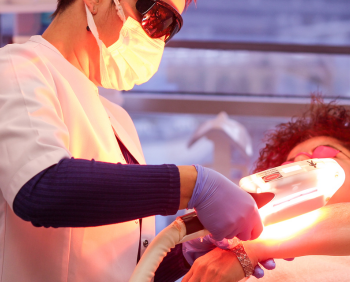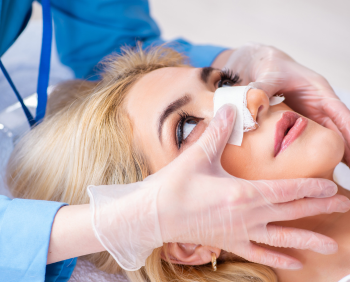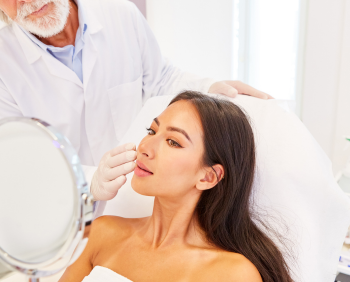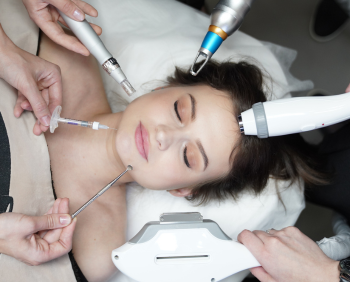Laser Skin Treatments Carry Serious Risks Most Clinics Downplay
Laser skin procedures promise smoother, younger skin but introduce genuine risks most clinics never mention. Every laser treatment causes controlled injury to the skin. For some, this triggers complications that last long after the redness fades. Anyone considering laser resurfacing must know both the routine side effects and rare, life-altering dangers backed by clinical evidence.
Everywhere you look, someone is advertising laser skin treatments. Med-spas, dentist’s offices, OB-GYN clinics, and family practices all claim to have the latest device that promises wrinkle removal, tighter skin, or a Fountain of Youth.
As someone who has owned wellness centers and medspas and has received extensive laser training, I have seen the real side of this business.
Here is what most people do not know:
Most of the people operating these lasers have only received training from the sales rep who sold the device. True, in-depth laser training is rare, and the few classes that exist are expensive, time-consuming, and usually require a doctor’s constant presence.
Most doctors are not willing to devote the necessary time for their aesthetician or laser tech to learn the science behind these devices. As a result, most operators have a superficial understanding of the lasers they use and cannot answer questions about long-term safety.
Hands-on experience matters, but experience alone does not make someone an expert in laser safety or skin biology. In my own practice, I often saw people coming in for help with damage caused by unskilled or undertrained technicians.
If you have ever felt disappointed after a laser treatment, you are not alone. The industry is saturated with hype, and most advertising exaggerates both the benefits and safety of lasers.
In reality, these treatments can offer improvements, but rarely without significant risk and lasting side effects.
Most clinics never discuss what does not work. They rarely talk about the long-term consequences of repeated procedures like botox, laser hair removal, or skin resurfacing. Many lasers actually create an injury that stimulates collagen production, but not all collagen is good.
Scar tissue, which feels thick, less elastic, and rough, often forms instead of healthy, flexible collagen.
When I examine someone’s skin, I can feel immediately if lasers have been overused; the tissue is different, often less resilient.
Your skin is your largest organ of detoxification. Scar tissue from repeated laser injuries interferes with this natural process, reducing the skin’s ability to clear toxins and respond to environmental stress.
[toc title=”Table of Contents” depth=”4″ toggle=”true”]
 Why You Should Be Skeptical About Laser Treatments at Medspas, Dentists, and Doctor’s Offices
Why You Should Be Skeptical About Laser Treatments at Medspas, Dentists, and Doctor’s Offices
My concentration is on exposing what does not work. I also educate people on the long-term risks of many popular therapies, like botox, laser hair removal or laser skin rejuvenation. I have my concerns about lasers; from efficacy, to technical and artistic ability of the doctor, aesthetician or tech running the laser. A degree or certification does not equal good results.
The technology behind lasers is sound in a controlled environment, yet long-term implications and risks, are not taken into consideration nor discussed with patients.
Very few aestheticians or technicians receive proper laser education, even in doctor’s offices. There are no controlled or required tune-ups for the lasers to determine they are indeed on spec.
What if the calibration of the lasers are off? In the age when lasers first came out, people had to calibrate them every day.
With the new lasers, they are self calibrating. Now how many times have you seen technology malfunction? Does your computer always do what it should? These are real concerns with the lasers.
Because the lasers burn and traumatize the skin, the targeted pigmentation in skin is often suppressed. Most people find that after their initial treatment of 6 laser sessions, they have to come back every 4-6 months to have the session repeated again.
Laser Skin Treatments Carry Serious Risks Many Clinics Overlook (Or Don’t Know)
Is Laser Skin Treatment Risky?
Laser skin procedures promise smoother, younger skin but introduce genuine risks many clinics never mention. Every session causes controlled injury to the skin, setting off a repair process that can lead to complications both short-term and long-term. Some risks are common knowledge, but many remain hidden even from practitioners.
 Five Hidden Dangers of Laser Skin Treatments Most Patients Never Hear About
Five Hidden Dangers of Laser Skin Treatments Most Patients Never Hear About
Ectropion Can Permanently Deform Eyelids
Laser energy near the eyes can cause the lower eyelid to turn outward, a complication called ectropion. People with loose eyelids or previous eyelid surgery are at higher risk. Ectropion can lead to chronic tearing, infection, and dryness.
Correction requires surgery, and normal eyelid function may never fully return.
Systemic Infections Can Spread Beyond the Skin
Lasers create thousands of microscopic wounds. For those with weak immune systems, these openings allow bacteria or fungi into the bloodstream.
Surface infections can escalate to sepsis, a life-threatening condition needing hospital care.
Delayed Hypopigmentation Can Leave Permanent White Patches
Months after a procedure, patchy white spots sometimes appear. This is most likely to be noticeable in people with medium or dark skin or tan. The laser destroys pigment cells, sometimes permanently.
This type of hypopigmentation may show up after the initial healing phase, and is often impossible to reverse.
Common Medications Increase the Risk of Severe Burns
Antibiotics like tetracyclines, some blood pressure medicines, and diuretics make the skin hypersensitive to light. Even if stopped weeks before a procedure, lingering effects can trigger severe burns and scarring.
Most clinics overlook less obvious drugs in their screening, exposing patients to unnecessary risk.
Certain Herbs And Supplements Should Be Stopped Before Laser Treatment
Several supplements and herbs increase bleeding, bruising, photosensitivity, or interfere with healing. These should be avoided before laser skin procedures:
Supplements and Herbs to Avoid Before Laser Treatments:
-
Fish Oil and Omega-3s
Increase bleeding and bruising risk. -
Vitamin E
Interferes with clotting, increases bruising. -
Ginkgo Biloba
Raises bleeding risk by inhibiting platelet aggregation. -
Garlic Supplements
May cause excessive bleeding. -
Ginseng
Anticoagulant effects; delays healing. -
St. John’s Wort
Strong photosensitizer, increases risk of burns and hyperpigmentation. -
Kava, Dong Quai, Feverfew, Turmeric, Ginger, and Willow Bark
All may increase bleeding or bruising risk. -
Melatonin
Can interfere with wound healing and immune response. -
High-dose Vitamin C or Multivitamins
In high doses, may increase capillary fragility or interact with medications.
How Long Before Treatment Should They Be Stopped?
Discontinue all supplements with anticoagulant or photosensitizing properties at least two weeks before your scheduled laser treatment unless otherwise advised by your provider.
Herpes Virus Reactivation Can Cause Severe Outbreaks
Laser trauma sometimes triggers dormant herpes viruses, leading to outbreaks even in those with no cold sore history.
These outbreaks slow healing, risk scarring, and require antiviral medication before treatment to reduce the chance of flare-ups.
 Who Should Avoid Laser Resurfacing?
Who Should Avoid Laser Resurfacing?
Laser resurfacing is especially risky or inadvisable for:
-
People who have used isotretinoin (Accutane) in the last year.
-
Anyone diagnosed with autoimmune disorders like lupus or scleroderma.
-
Individuals with a history of keloid scars or facial radiation.
-
Those with Fitzpatrick skin types IV to VI (medium to dark skin) due to higher risk of pigment changes.
-
Pregnant or breastfeeding women.
-
Anyone with loose lower eyelids, since the risk of ectropion is extremely high.
How Many Years Does Laser Treatment Take Off Your Face?
Non-ablative lasers may provide one to two years of visible improvement. Aggressive, ablative CO₂ lasers can offer three to five years, and some claim up to a decade with very strong settings.
However, these improvements fade over time, require ongoing maintenance, and are highly dependent on sun avoidance and skin care.
 Does Laser Skin Treatment Make Future Facelift Surgery More Difficult?
Does Laser Skin Treatment Make Future Facelift Surgery More Difficult?
Yes. Laser skin resurfacing changes the structure and quality of the skin in ways that can complicate later surgical procedures, especially facelifts. Here’s why:
1. Skin Thinning and Scarring
Ablative and even some non-ablative lasers remove surface layers and stimulate collagen, but repeated or aggressive treatments can leave the skin permanently thinner and less elastic. Thinned skin is more fragile, tears easily during surgical dissection, and does not hold stitches as well.
Subtle scarring in the deeper layers also disrupts normal anatomy, making precise surgical lifting and repositioning more challenging for the surgeon.
2. Altered Blood Supply
Laser energy can damage small blood vessels beneath the skin, reducing blood flow to critical areas. This impairs healing after a facelift, increases risk of wound breakdown, and raises the likelihood of visible scarring or skin loss.
3. Reduced Skin Elasticity
Lasers often create new collagen, but this collagen is not always as healthy or flexible as natural tissue. Scar-like collagen is stiffer, making it harder for the skin to be repositioned during surgery and increasing the risk of a tight, unnatural look.
4. Complicated Dissection Planes
Facelift surgery relies on natural tissue planes for safe and effective lifting. Previous laser resurfacing blurs or scars these planes, making surgery technically more difficult and sometimes less predictable.
Surgeons must often use modified techniques, which may not deliver the same results as standard facelifts.
5. Longer Recovery and Higher Risk of Complications
Because of these tissue changes, recovery after facelift is slower. There’s a higher chance of delayed healing, infection, and poor cosmetic outcomes.
Surgical Guidance:
Most plastic surgeons recommend waiting at least six to twelve months after any aggressive laser treatment before considering a facelift. Full disclosure of all past laser treatments is essential for surgical planning.
In some cases, prior laser resurfacing may limit the degree of improvement a facelift can safely achieve or rule out surgery entirely for certain candidates.
 How Lasers Accelerate Cellular Aging and the Hayflick Limit
How Lasers Accelerate Cellular Aging and the Hayflick Limit
The Hayflick limit describes the number of times a skin cell can divide before it enters a state of senescence, or permanent inactivity. Each time your skin is injured and repairs itself, it draws on this limited pool of divisions.
Laser treatments deliberately injure the skin, prompting rapid cell turnover and healing.
Frequent or aggressive laser sessions push your skin cells closer to their replicative limit, accelerating the appearance of aging, thinning, and loss of resilience.
In the short run, you may see new collagen, but much of it is scar tissue rather than the strong, flexible collagen you want.
Overusing lasers shortens the lifespan of your skin, making it less able to recover and more prone to premature aging and chronic problems.
Pre-Treatment Steps That Protect Against Complications
Medication, Supplement & Herbals Review
Discontinue all photosensitizing medicines, supplements and herbs. These include NSAIDs, topical retinoids, and certain antibiotics for at least two to four weeks before treatment.
Universal Antiviral Protocol
Begin valacyclovir at least two days before your procedure to reduce the chance of herpes outbreaks.
Strict Sun Avoidance
Avoid sun exposure for eight weeks before and after laser treatments. Even brief exposure increases the risk of burns and pigment problems.
Sources


-
Pingback: hoc nhat ban
-
Pingback: anabolic blast
-
Pingback: dien dan mua ban
-
Pingback: Taxi Seri
-
Pingback: Homepage
-
Pingback: My Blog
Comments are closed.